Paleoenvironmental Controls on Organic Matter Enrichment in Member 4 of the Yingcheng Formation Source Rocks, Xujiaweizi Fault Depression
Abstract
1. Introduction
2. Geological Setting
3. Sample and Method
4. Result
5. Discussion
5.1. Paleoclimate
5.2. Paleoredox Conditions
5.3. Paleosalinity
5.4. Paleoproductivity and Paleowater Depth
5.5. Main Controlling Factors and Enrichment Patterns of Organic Matter
6. Conclusions
Author Contributions
Funding
Institutional Review Board Statement
Informed Consent Statement
Data Availability Statement
Conflicts of Interest
References
- Wang, C.; Feng, Z.; Zhang, L.; Huang, Y.; Cao, K.; Wang, P.; Zhao, B. Cretaceous paleogeography and paleoclimate and the setting of SKI borehole sites in Songliao Basin, northeast China. Palaeogeogr. Palaeoclimatol. Palaeoecol. 2013, 385, 17–30. [Google Scholar] [CrossRef]
- Peters, K.E.; Snedden, J.W.; Sulaeman, A.; Sarg, J.F.; Enrico, R.J. A new geochemical-sequence stratigraphic model for the Mahakam Delta and Makassar Slope, Kalimantan, Indonesia. AAPG Bull. 2000, 84, 12–44. [Google Scholar]
- Berner, R.A.; Kothavala, Z. Geocarb III: A Revised Model of Atmospheric CO2 over Phanerozoic Time. Am. J. Sci. 2001, 301, 182. [Google Scholar] [CrossRef]
- Zhou, X.; He, S.; Chen, Z.; Liu, P.; Wang, F. Characteristics and Controlling factors of Source rocks in Yanchang Formation sequence framework, Ordos Basin. Earth Sci. 2016, 41, 1055–1066. [Google Scholar]
- Liu, Y.; Huang, C.; Yue, J.; Guo, L. Analysis of organic matter characteristics and their controlling factors in the sequence stratigraphic framework: Case study of Jurassic Dongyuemiao member of the Ziliujin Formation in Jiannan area, Upper and Middle Yangtze region. Nat. Gas Geosci. 2017, 28, 930–938. [Google Scholar]
- Yin, J.; Wang, Q.; Hao, F.; Guo, L.X.; Zou, H.Y. Paleolake environment and depositional model of source rocks of the Lower Submember of Shal in Raoyang Sag, Bohai Bay Basin. Earth Sci. 2017, 42, 1209–1222. [Google Scholar]
- Liu, C.; Zhao, W.; Sun, L.; Wang, X.; Sun, Y.; Zhang, Y.; Zhang, J.; Zhang, L.; Li, J. Geochemical assessment of the newly discovered oil-type Shale in the Shuangcheng area of the northern Songliao Basin, China. J. Pet. Sci. Eng. 2020, 196, 107755. [Google Scholar] [CrossRef]
- Zhong, A.; Zhou, X. Provenance and sedimentary system analysis of the Shahezi Formation in the Xujiaweizi Fault Depression, Songliao Basin. Acta Sedimentol. Sin. 2020, 38, 610–619. [Google Scholar]
- Lu, J.; Liu, C. Accumulation conditions and resource potential of tight glutenite gas in fault depression basins: A case study on Lower Cretaceous Shahezi Formation in Xujiaweizi fault depression, Songliao Basin. China Pet. Explor. 2016, 21, 53–60. [Google Scholar]
- Zhang, J.; Fang, W.; Li, J.; Huo, Q. Deep gases and their genetic types of the Xujiaweizi fault depression zone, Songliao Basin and their contribution. Acta Geol. Sin. 2009, 83, 579–589. [Google Scholar]
- Bai, X.; Liang, J.; Zhang, W.; Fu, L.; Peng, J.; Xue, T.; Yang, L.; Liu, J. Geologic conditions, resource potential and exploratory direction of deep gas in the northern Songliao Basin. Nat. Gas Geosci. 2018, 29, 1443–1454. [Google Scholar]
- Zhang, F.; Ran, Q.; Wu, Y.; Ren, Z. Geochemical characteristics and reservoir forming conditions of the natural gas in the paleo central uplift zone in the northern Songliao Basin. Nat. Gas Geosci. 2019, 30, 126–132. [Google Scholar]
- Fan, D. Research on Paleoclimate, Paleoenvironment and Source Rock Development Model of the Cretaceous Shahezi Formation in Xujiaweizi Fault Depression, Songliao Basin. Master’s Thesis, Jilin University, Changchun, China, 2022. [Google Scholar]
- Shao, Z.; Wu, C.; Zhang, D.; Yang, B. Reservoir characteristics and controlling factors of Shahezi Formation in Xujiaweizi Fault Depression, Songliao Basin. Oil Gas Geol. 2019, 40, 101–108. [Google Scholar]
- Sun, L.; Yang, L.; Li, X.; Zhou, X.; Hu, B.; Cai, Z.; Du, Y. Paleoenvironment and Main Controlling Factors of Source Rocks in the Shahezi Formation, Xujiaweizi Fault Depression. Acta Sedimentol. Sin. 2024, 42, 1753–1764. [Google Scholar]
- GB/T 19145-2022; Determination of Total Organic Carbon in Sedimentary Rocks. China Standards Press: Beijing, China, 2022.
- GB/T 14506.28-2010; Methods for Chemical Analysis of Silicate Rocks—Part 28: Determination of 16 Major and Minor Elements Content. China Standards Press: Beijing, China, 2010.
- GB/T 14506.30-2010; Methods for Chemical Analysis of Silicate Rocks—Part 30: Determination of 44 Elements. China Standards Press: Beijing, China, 2010.
- Bendell-Young, L.I.; Thomas, C.A.; Stecko, J.R.P. Contrasting the geochemistry of oxic sediments across ecosystems: A synthesis. Appl. Geochem. 2002, 17, 1563–1582. [Google Scholar] [CrossRef]
- Cato, I. Recent Sedimentological and Geochemical Conditions and Pollution Problems in Two Marine Areas in South-Western Sweden; Striae: Upsala, Sweden, 1977. [Google Scholar]
- Wedepohl, K.H. Environmental influences on the chemical composition of shales and clays. Phys. Chem. Earth 1971, 8, 307–333. [Google Scholar] [CrossRef]
- Zhang, M.; Zhu, X.; Jiang, Z. Main controlling factors of organic matter enrichment in continental freshwater lacustrine shale: A case study of the Jurassic Ziliujing Formation in northeastern Sichuan Basin. J. Palaeogeogr. 2023, 25, 806–822. [Google Scholar]
- Davison, W. Iron and manganese in lakes. Earth-Sci. Rev. 1993, 34, 119–163. [Google Scholar] [CrossRef]
- Ding, C.; Pang, Y.; Meng, Y.; Huang, Y.; Li, W.; Zhang, S.; Guo, H.; Li, J.; Zhang, M. Study of the Paleoenvironment and Reservoir Mechanism for Volcanic Rich Clastic Reservoirs in the Upper Urho Formation in the Zhongguai Region, Junggar Basin. Acta Sedimentol. Sin. 2020, 38, 851–867. [Google Scholar]
- Wei, W.; Algeo, T.J. Elemental proxies for paleosalinity analysis of ancient shales and mudrocks. Geochim. Et Cosmochim. Acta 2020, 287, 341–366. [Google Scholar] [CrossRef]
- Rieu, R.; Allen, P.A.; Pltze, M.; Pettke, T. Climatic cycles during a Neoproterozoic “snowball” glacial epoch. Geology 2007, 35, 299–302. [Google Scholar] [CrossRef]
- Tribovillard, N.; Algeo, T.J.; Lyons, T.; Riboulleau, A. Trace metals as paleoredox and paleoproductivity proxies: An update. Chem. Geol. 2006, 232, 12–32. [Google Scholar] [CrossRef]
- Hatch, J.R.; Leventhal, J.S. Relationship between inferred redox potential of the depositional environment and geochemistry of the Upper Pennsylvanian (Missourian)Stark Shale Member of the Dennis Limestone, Wabaunsee County, KS, USA. Chem. Geol. 1992, 99, 65–82. [Google Scholar] [CrossRef]
- Meng, Q.; Liu, Z.; Bruch, A.A.; Liu, R.; Hu, F. Palaeoclimatic evolution during Eocene and its influence on oil shale mineralisation, Fushun basin, China. J. Asian Earth Sci. 2012, 45, 95–105. [Google Scholar] [CrossRef]
- Schoepfer, S.D.; Shen, J.; Wei, H.; Tyson, R.V.; Ingall, E.; Algeo, T.J. Total organic carbon, organic phosphorus, and biogenic barium fluxes as proxies for paleomarine productivity. Earth-Sci. Rev. 2015, 149, 23–52. [Google Scholar] [CrossRef]
- Ayinla, H.A.; Abdullah, W.H.; Makeen, Y.M.; Abubakar, M.; Jauro, A.; Yandoka, B.M.S.; Abidin, N.S.Z. Petrographic and geochemical characterization of the Upper Cretaceous coal and mudstones of Gombe Formation, Gongola sub-basin, northern Benue trough Nigeria: Implication for organic matter preservation, paleodepositional environment and tectonic settings. Int. J. Coal Geol. 2017, 180, 67–82. [Google Scholar] [CrossRef]
- Sun, H.; Gao, J.; Fu, L.; Bai, Y.; Zhang, T.; Chen, C.; Yuan, L.; Liu, B. Restoration of Ordovician paleoenvironment and analysis of sedimentary system in the western margin of Ordos Basin. J. Northeast Pet. Univ. 2023, 47, 44–65+69+7–8. [Google Scholar]


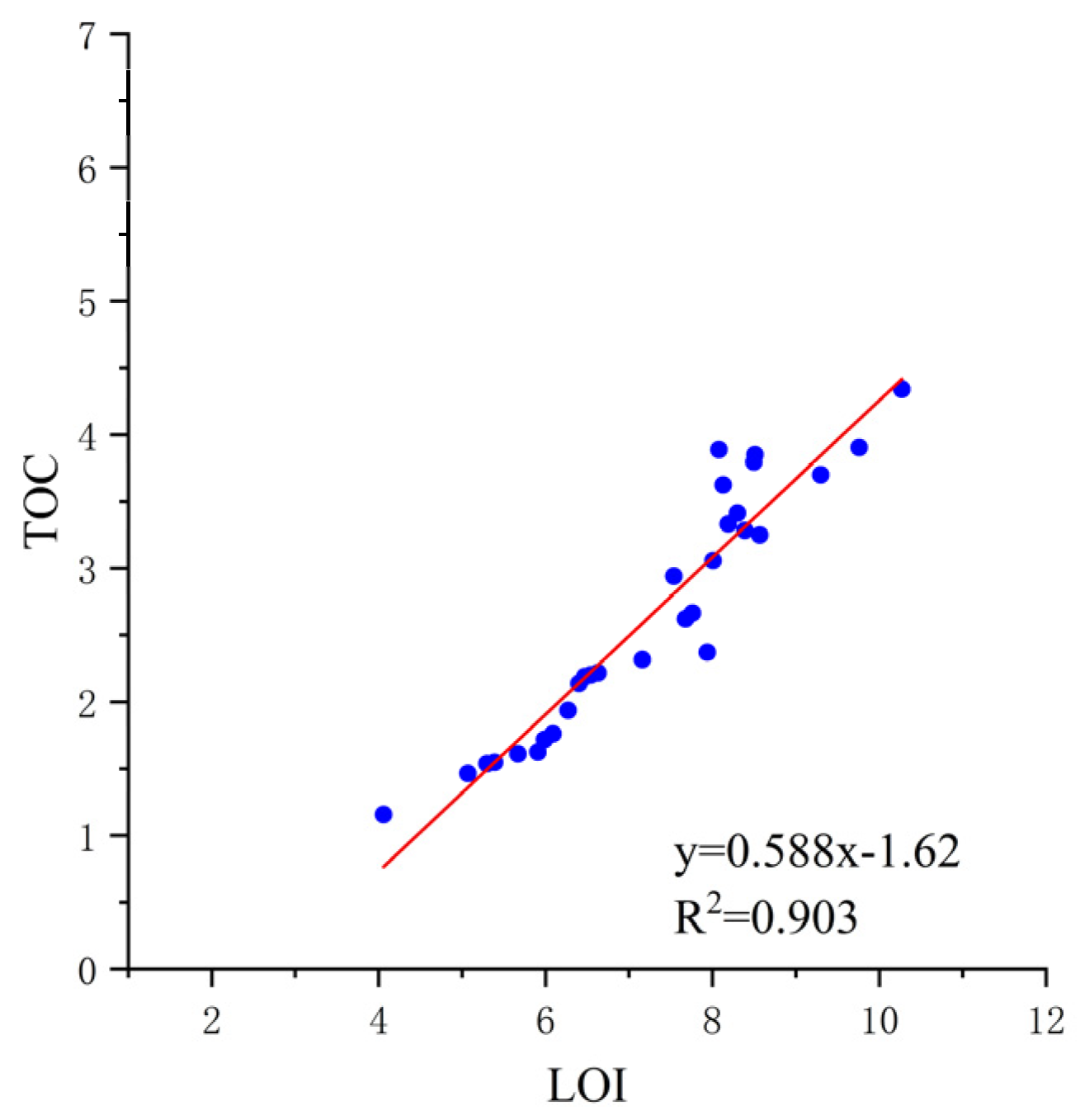


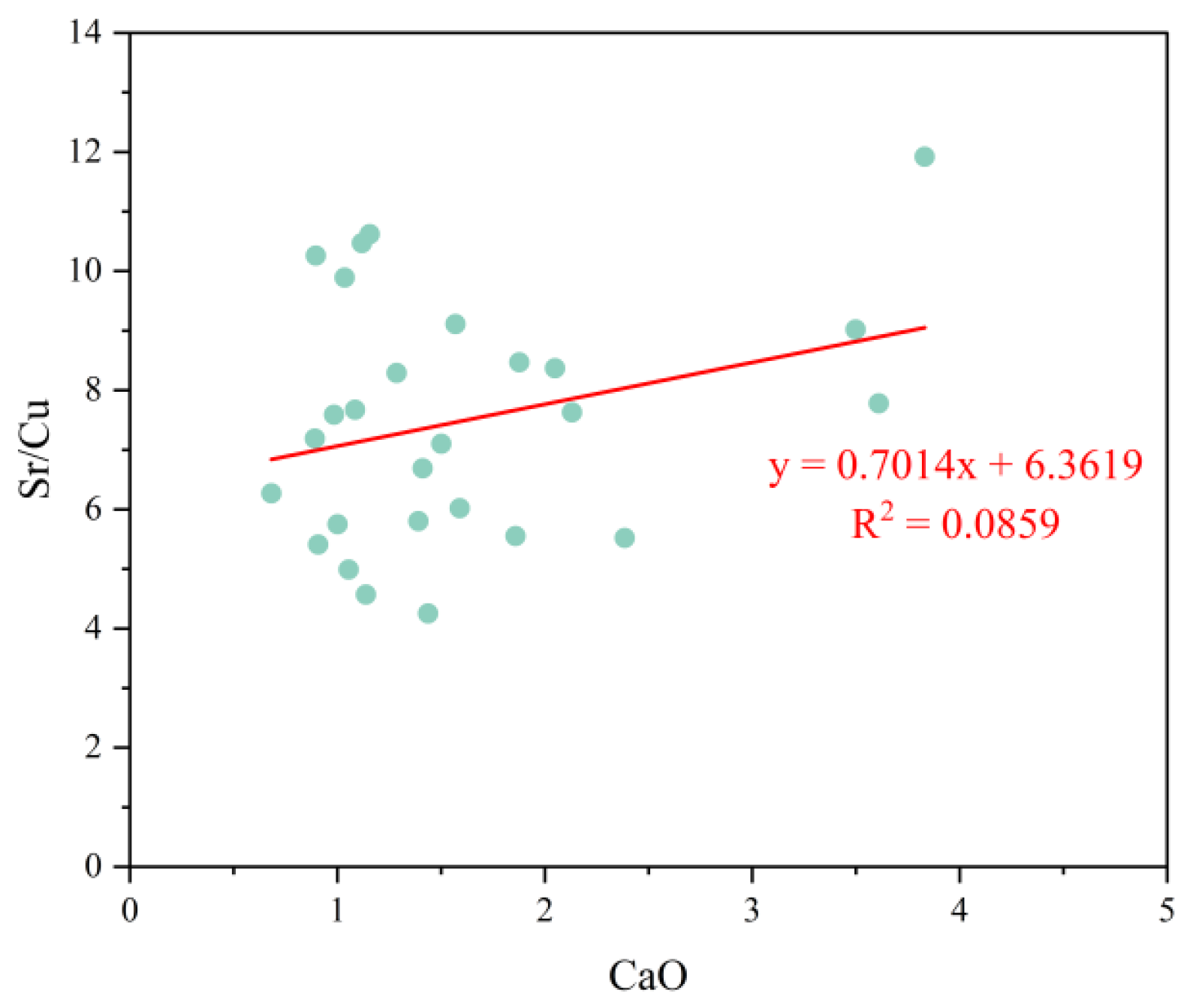

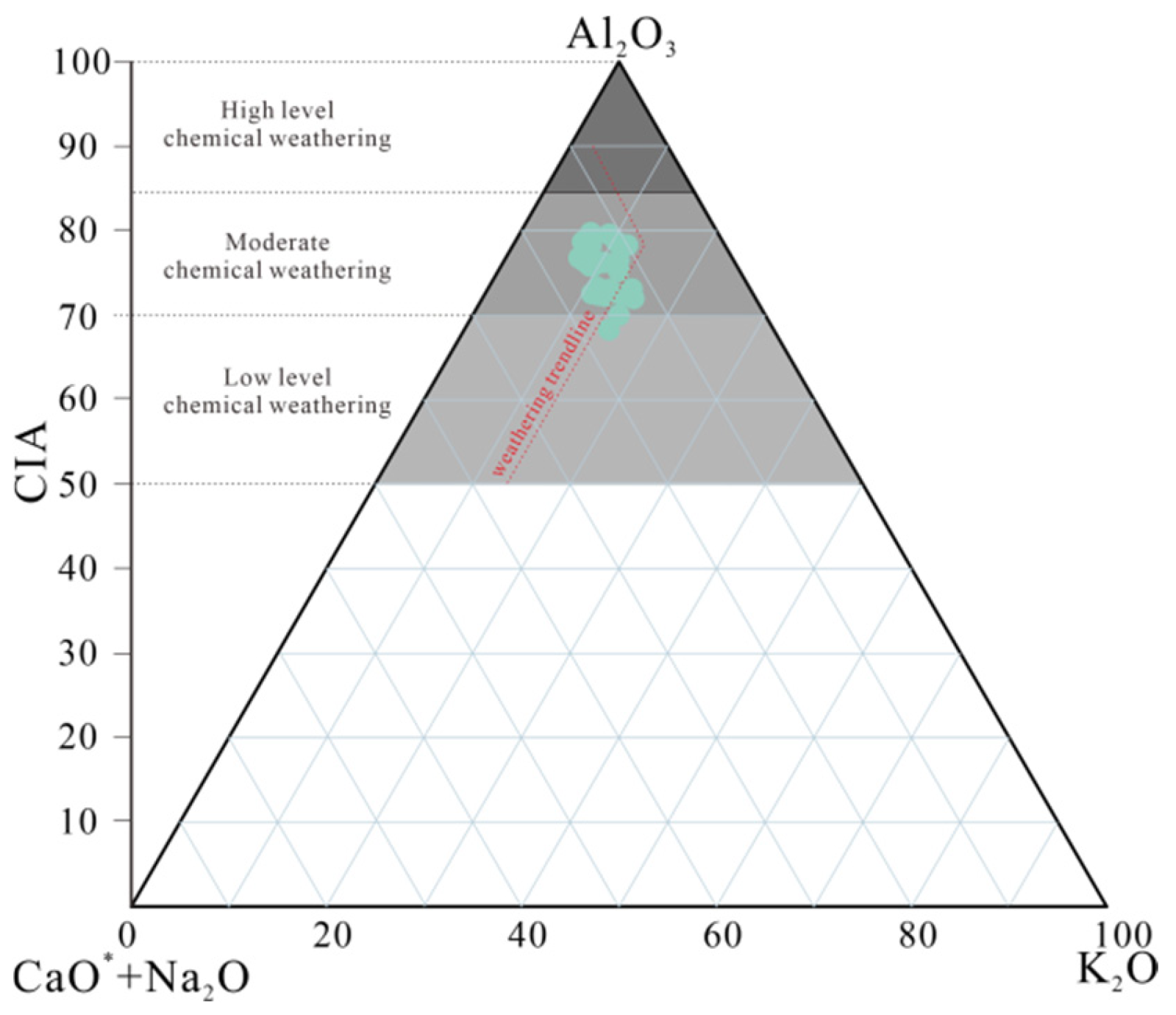
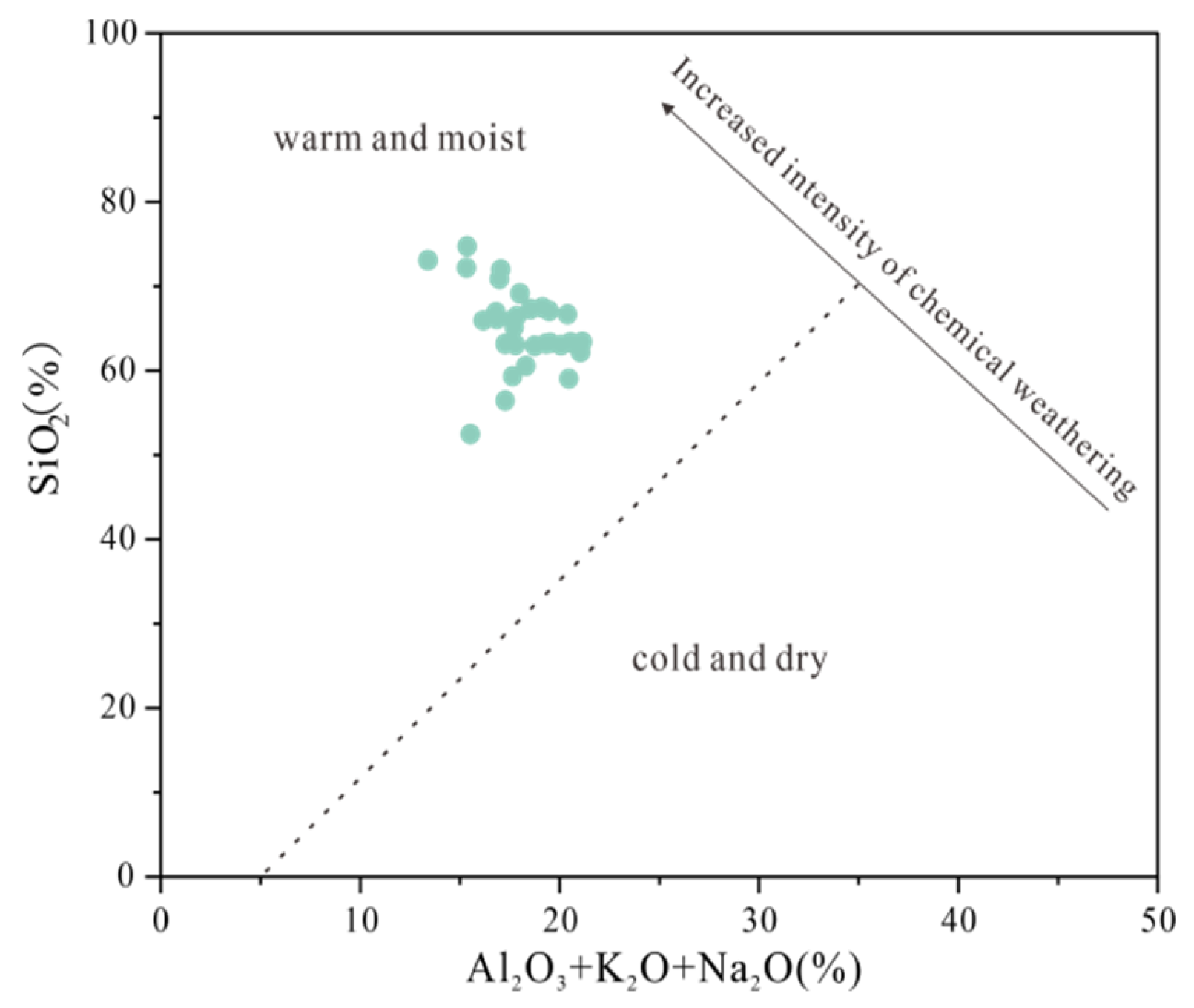


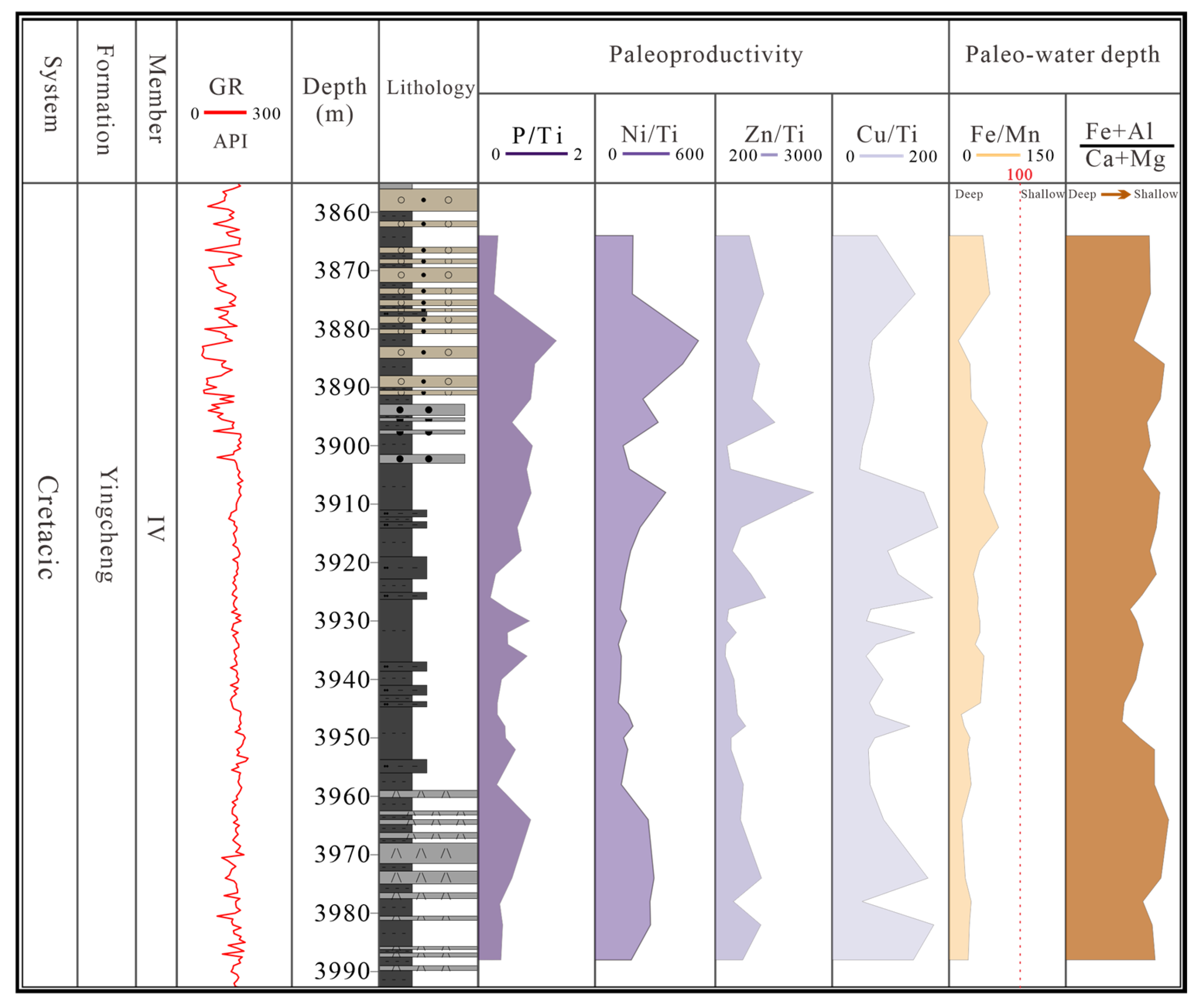


| Depth/m | Al2O3 | CaO | Fe2O3 | MnO | P2O5 | K2O | SiO2 | Na2O | TiO2 | MgO | LOI | TOC |
|---|---|---|---|---|---|---|---|---|---|---|---|---|
| 3864 | 12.347 | 1.119 | 3.639 | 0.076 | 0.140 | 2.300 | 72.005 | 2.412 | 0.395 | 0.378 | 5.07 | 1.157 |
| 3874 | 13.076 | 1.138 | 3.784 | 0.065 | 0.099 | 2.973 | 69.151 | 1.958 | 0.496 | 0.484 | 6.09 | 1.464 |
| 3882 | 9.278 | 4.407 | 2.028 | 0.154 | 0.069 | 1.572 | 73.074 | 2.547 | 0.209 | 0.207 | 5.67 | 1.537 |
| 3886 | 10.700 | 2.002 | 3.160 | 0.105 | 0.104 | 1.999 | 72.203 | 2.639 | 0.293 | 0.312 | 6.4 | 1.547 |
| 3892 | 11.085 | 1.652 | 3.257 | 0.102 | 0.082 | 1.924 | 74.721 | 2.364 | 0.309 | 0.328 | 4.06 | 1.611 |
| 3896 | 14.285 | 1.156 | 4.689 | 0.086 | 0.125 | 3.047 | 67.068 | 2.152 | 0.464 | 0.564 | 6.27 | 1.624 |
| 3900 | 14.208 | 1.286 | 4.909 | 0.106 | 0.158 | 2.783 | 67.272 | 1.560 | 0.537 | 0.627 | 5.99 | 1.717 |
| 3904 | 14.623 | 1.035 | 4.722 | 0.092 | 0.133 | 2.938 | 67.488 | 1.582 | 0.534 | 0.522 | 5.91 | 1.761 |
| 3908 | 12.943 | 1.859 | 4.349 | 0.088 | 0.136 | 2.734 | 66.128 | 2.020 | 0.418 | 0.526 | 8.57 | 1.936 |
| 3914 | 14.233 | 1.502 | 4.798 | 0.068 | 0.256 | 2.828 | 62.962 | 1.686 | 0.446 | 0.873 | 6.47 | 2.138 |
| 3918 | 15.797 | 1.411 | 4.956 | 0.112 | 0.687 | 3.229 | 63.345 | 1.525 | 0.554 | 0.572 | 7.76 | 2.189 |
| 3922 | 14.174 | 1.877 | 5.964 | 0.172 | 0.608 | 2.630 | 60.569 | 1.513 | 0.513 | 0.722 | 10.27 | 2.202 |
| 3926 | 11.920 | 3.610 | 4.718 | 0.113 | 0.321 | 2.276 | 52.482 | 1.332 | 0.411 | 0.703 | 9.3 | 2.217 |
| 3928 | 16.671 | 0.892 | 6.445 | 0.158 | 0.411 | 2.881 | 62.173 | 1.506 | 0.585 | 0.581 | 7.54 | 2.316 |
| 3930 | 15.475 | 0.896 | 5.007 | 0.114 | 0.249 | 3.019 | 66.698 | 1.914 | 0.531 | 0.534 | 5.3 | 2.941 |
| 3932 | 15.645 | 1.055 | 5.988 | 0.136 | 0.482 | 2.597 | 63.298 | 1.285 | 0.521 | 0.644 | 7.68 | 2.621 |
| 3934 | 16.450 | 1.391 | 6.914 | 0.187 | 0.757 | 2.859 | 59.056 | 1.158 | 0.542 | 0.615 | 9.76 | 2.664 |
| 3936 | 16.016 | 1.086 | 5.598 | 0.113 | 0.405 | 2.618 | 63.028 | 1.434 | 0.561 | 0.582 | 8.51 | 2.37 |
| 3940 | 15.446 | 0.908 | 5.992 | 0.126 | 0.341 | 2.610 | 63.208 | 1.270 | 0.472 | 0.646 | 8.01 | 3.057 |
| 3944 | 16.764 | 0.682 | 6.456 | 0.143 | 0.283 | 2.921 | 63.392 | 1.455 | 0.552 | 0.683 | 6.54 | 3.888 |
| 3946 | 13.603 | 3.499 | 8.480 | 0.475 | 4.676 | 2.445 | 56.435 | 1.219 | 0.431 | 0.569 | 8.08 | 3.623 |
| 3948 | 13.896 | 2.385 | 7.572 | 0.354 | 2.888 | 2.542 | 59.323 | 1.207 | 0.447 | 0.604 | 8.5 | 3.331 |
| 3950 | 13.978 | 1.001 | 6.191 | 0.207 | 0.413 | 2.466 | 66.479 | 1.417 | 0.428 | 0.641 | 6.63 | 3.411 |
| 3952 | 13.239 | 2.050 | 7.474 | 0.279 | 1.312 | 2.036 | 63.168 | 1.996 | 0.449 | 0.598 | 7.16 | 3.283 |
| 3958 | 13.539 | 1.570 | 5.524 | 0.177 | 0.436 | 2.385 | 65.152 | 1.803 | 0.434 | 0.590 | 8.13 | 3.795 |
| 3964 | 13.031 | 3.831 | 5.555 | 0.299 | 0.211 | 2.163 | 63.057 | 2.599 | 0.358 | 0.452 | 8.19 | 3.849 |
| 3974 | 11.839 | 2.132 | 5.067 | 0.217 | 1.655 | 2.340 | 65.946 | 2.001 | 0.325 | 0.449 | 7.94 | 3.249 |
| 3978 | 12.347 | 0.984 | 4.529 | 0.144 | 0.228 | 2.658 | 70.879 | 1.975 | 0.364 | 0.406 | 5.39 | 3.904 |
| 3982 | 12.187 | 1.438 | 4.841 | 0.168 | 0.234 | 2.673 | 66.909 | 1.955 | 0.390 | 0.408 | 8.3 | 4.34 |
| 3988 | 12.198 | 1.590 | 4.909 | 0.177 | 0.647 | 2.582 | 66.128 | 2.074 | 0.394 | 0.442 | 8.39 | 3.7 |
| Depth/m | V | Cr | Co | Ni | Cu | Zn | Rb | Sr | Ba | Tl | Zr |
|---|---|---|---|---|---|---|---|---|---|---|---|
| 3864 | 42.739 | 80.314 | 6.687 | 44.996 | 18.311 | 238.942 | 80.798 | 191.760 | 6476.34 | 0.411 | 307.347 |
| 3874 | 56.822 | 109.889 | 8.232 | 55.859 | 42.284 | 403.588 | 109.048 | 193.425 | 4996.36 | 0.518 | 430.790 |
| 3882 | 29.727 | 159.291 | 4.973 | 64.440 | 8.674 | 118.500 | 57.042 | 296.462 | 2858.80 | 0.290 | 224.361 |
| 3886 | 33.774 | 215.684 | 5.812 | 76.715 | 11.118 | 221.671 | 70.099 | 203.080 | 3202.16 | 0.349 | 288.397 |
| 3892 | 43.460 | 179.460 | 7.151 | 44.283 | 13.425 | 199.663 | 89.270 | 259.848 | 3333.77 | 0.378 | 389.909 |
| 3896 | 56.259 | 260.888 | 8.884 | 87.289 | 17.781 | 453.338 | 112.404 | 188.823 | 3116.40 | 0.602 | 451.143 |
| 3900 | 45.127 | 141.901 | 6.778 | 44.603 | 16.813 | 152.801 | 138.314 | 139.415 | 875.395 | 0.639 | 515.124 |
| 3904 | 51.064 | 150.274 | 7.242 | 55.354 | 15.064 | 181.435 | 137.518 | 149.053 | 1462.52 | 0.665 | 523.618 |
| 3908 | 59.889 | 203.673 | 8.740 | 88.476 | 39.254 | 1390.16 | 120.334 | 217.816 | 5547.32 | 0.611 | 417.616 |
| 3914 | 109.521 | 147.103 | 9.640 | 59.875 | 48.449 | 218.342 | 162.887 | 344.020 | 36215.7 | 0.871 | 518.533 |
| 3918 | 76.067 | 147.926 | 9.010 | 59.356 | 31.663 | 199.870 | 133.833 | 211.749 | 10497.3 | 0.688 | 511.265 |
| 3922 | 91.875 | 95.895 | 8.350 | 46.209 | 34.648 | 322.322 | 129.653 | 293.510 | 21615.3 | 0.678 | 410.782 |
| 3926 | 100.073 | 71.921 | 8.668 | 32.807 | 42.458 | 344.780 | 135.677 | 330.324 | 36611.7 | 0.720 | 449.687 |
| 3928 | 83.202 | 93.965 | 10.414 | 43.506 | 23.060 | 183.658 | 191.068 | 165.701 | 1418.44 | 0.993 | 608.260 |
| 3930 | 68.585 | 135.635 | 9.204 | 50.311 | 18.855 | 154.762 | 139.780 | 193.526 | 2419.64 | 0.718 | 454.832 |
| 3932 | 84.967 | 108.816 | 10.506 | 41.871 | 44.082 | 217.775 | 185.348 | 220.111 | 13908.3 | 0.919 | 656.552 |
| 3934 | 61.694 | 74.381 | 8.733 | 37.499 | 24.746 | 145.505 | 176.404 | 143.510 | 2375.02 | 0.889 | 558.146 |
| 3936 | 67.006 | 123.318 | 7.979 | 43.975 | 19.558 | 146.629 | 153.910 | 150.000 | 3687.58 | 0.781 | 558.093 |
| 3940 | 63.764 | 72.553 | 8.181 | 36.082 | 24.701 | 182.311 | 157.396 | 133.528 | 3509.11 | 0.795 | 531.088 |
| 3944 | 67.013 | 77.834 | 9.092 | 38.812 | 21.288 | 233.983 | 186.329 | 133.418 | 2018.94 | 0.964 | 805.111 |
| 3946 | 58.552 | 62.747 | 7.159 | 42.844 | 19.114 | 187.414 | 155.761 | 172.364 | 1735.02 | 0.824 | 646.350 |
| 3948 | 97.068 | 113.915 | 10.892 | 50.544 | 35.604 | 249.395 | 239.318 | 196.531 | 3762.82 | 1.203 | 1017.93 |
| 3950 | 54.444 | 70.604 | 6.958 | 36.246 | 18.771 | 149.909 | 144.754 | 107.913 | 1312.97 | 0.709 | 580.941 |
| 3952 | 55.133 | 100.060 | 7.948 | 43.717 | 16.716 | 155.585 | 112.972 | 139.928 | 1061.51 | 0.593 | 466.813 |
| 3958 | 46.919 | 73.794 | 7.005 | 33.993 | 16.921 | 228.634 | 126.191 | 154.198 | 5815.73 | 0.622 | 539.038 |
| 3964 | 26.997 | 154.450 | 7.751 | 56.721 | 18.899 | 172.167 | 99.201 | 225.349 | 12198.2 | 0.503 | 672.436 |
| 3974 | 45.467 | 147.907 | 9.201 | 57.059 | 32.015 | 255.454 | 120.342 | 244.367 | 17522.6 | 0.617 | 522.198 |
| 3978 | 24.280 | 164.127 | 4.797 | 59.430 | 11.140 | 139.155 | 81.320 | 84.536 | 1353.26 | 0.397 | 465.007 |
| 3982 | 45.527 | 126.649 | 9.999 | 64.923 | 40.783 | 303.407 | 120.103 | 173.229 | 9256.54 | 0.794 | 557.539 |
| 3988 | 48.239 | 80.204 | 6.067 | 42.622 | 32.738 | 203.407 | 100.461 | 197.151 | 9835.17 | 0.582 | 443.952 |
Disclaimer/Publisher’s Note: The statements, opinions and data contained in all publications are solely those of the individual author(s) and contributor(s) and not of MDPI and/or the editor(s). MDPI and/or the editor(s) disclaim responsibility for any injury to people or property resulting from any ideas, methods, instructions or products referred to in the content. |
© 2025 by the authors. Licensee MDPI, Basel, Switzerland. This article is an open access article distributed under the terms and conditions of the Creative Commons Attribution (CC BY) license (https://creativecommons.org/licenses/by/4.0/).
Share and Cite
Wang, Z.; Zhang, Y.; Yu, X.; Li, Y.; Hou, Y.; Sun, L.; Yang, L.; Xu, J. Paleoenvironmental Controls on Organic Matter Enrichment in Member 4 of the Yingcheng Formation Source Rocks, Xujiaweizi Fault Depression. Appl. Sci. 2025, 15, 3321. https://doi.org/10.3390/app15063321
Wang Z, Zhang Y, Yu X, Li Y, Hou Y, Sun L, Yang L, Xu J. Paleoenvironmental Controls on Organic Matter Enrichment in Member 4 of the Yingcheng Formation Source Rocks, Xujiaweizi Fault Depression. Applied Sciences. 2025; 15(6):3321. https://doi.org/10.3390/app15063321
Chicago/Turabian StyleWang, Zeqiang, Yunfeng Zhang, Xuntao Yu, Yilin Li, Yanhua Hou, Lidong Sun, Liang Yang, and Jinshuang Xu. 2025. "Paleoenvironmental Controls on Organic Matter Enrichment in Member 4 of the Yingcheng Formation Source Rocks, Xujiaweizi Fault Depression" Applied Sciences 15, no. 6: 3321. https://doi.org/10.3390/app15063321
APA StyleWang, Z., Zhang, Y., Yu, X., Li, Y., Hou, Y., Sun, L., Yang, L., & Xu, J. (2025). Paleoenvironmental Controls on Organic Matter Enrichment in Member 4 of the Yingcheng Formation Source Rocks, Xujiaweizi Fault Depression. Applied Sciences, 15(6), 3321. https://doi.org/10.3390/app15063321





